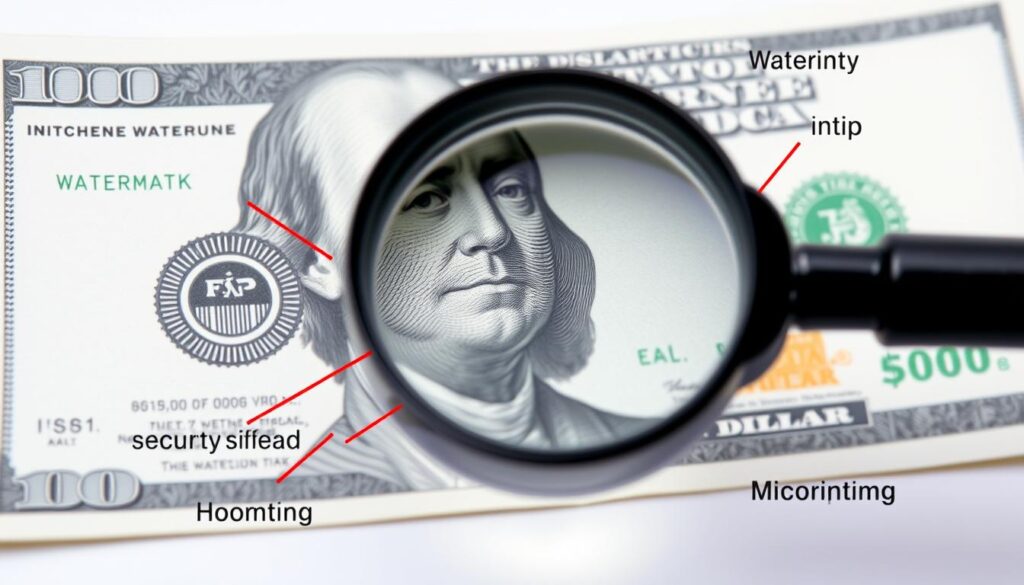Protecting yourself from fake money is vital in today’s world. The $100 bill needs careful checking as it’s the most valuable U.S. paper currency1. About $70 million in fake bills are out there, making verification crucial1.
Checking bills isn’t just about saving money. It’s about knowing the complex security features that stop fraud. Since 1990, U.S. bills have gotten major upgrades to boost security2.
Today’s $100 bill has many layers of protection. These features make it easier than ever to spot fakes.
Key Takeaways
- Multiple security features help identify genuine $100 bills
- Visual and tactile checks can reveal counterfeit currency
- Technology offers additional verification methods
- Understanding security features is crucial for protection
- Penalties for using counterfeit bills can be severe
Examine Key Security Features
Modern $100 bills have sophisticated security features to protect against counterfeiting. An estimated 70 to 200 million fake dollar bills circulate in the US. It’s crucial to know how to spot real currency3.
The $100 bill showcases top-notch anti-counterfeiting technology. Designers have added multiple UV security features to thwart fraudsters4. These intricate details make copying authentic bills extremely difficult.
The Watermark Technique
Watermark inspection is key for verifying bill authenticity. Hold the bill up to light to see a faint image of Benjamin Franklin. This watermark appears on both sides of the bill4.
Color-Shifting Ink Innovation
The color-shifting ink is a fascinating security feature. Tilt the bill to see the number 100 change from copper to green. This dynamic element makes counterfeiting much harder4.
Microprinting Details
Microprinting is an advanced anti-counterfeiting measure introduced in 1990. These tiny text details are nearly impossible to copy with standard equipment. Real $100 bills have specific security elements.
- Red and blue security fibers
- Unique paper composition (1/4 linen, 3/4 cotton)
- Precise microprinted text
Understanding these features helps you verify $100 bills with confidence3. You can now spot real currency and protect yourself from fakes.
Conduct a Simple Touch Test
Your sense of touch can help detect fake Federal Reserve Notes. Authentic currency has unique tactile features that counterfeiters struggle to copy. The Paper Money Validation process benefits from this method5.
Feel the Texture
Real U.S. currency is made from 75% cotton and 25% linen. This blend gives bills a unique feel. Genuine notes have a slightly rough texture, unlike regular paper5.
Run the bill between your fingers. A real note will have a crisp, slightly raised surface. This texture sets it apart from counterfeit bills.
Check for Raised Print
Genuine currency has raised print, a key feature. The portrait and certain design elements feel slightly embossed. This results from the U.S. Treasury’s intaglio printing process5.
On a $100 bill, run your finger across Benjamin Franklin’s portrait. You should feel a subtle texture. Counterfeiters find this hard to duplicate accurately.
- Authentic bills have a unique cotton-linen texture
- Raised print can be felt with your fingertips
- Counterfeit bills often feel smooth or flat
Trust your sense of touch – it’s one of the most reliable ways to identify genuine currency.
The touch test is helpful but shouldn’t be used alone. Combine it with other methods for reliable Counterfeit Detection6. If a bill feels off, compare it with a known genuine one5.
Use Technology for Verification
Modern tech offers powerful tools to spot fake bills quickly. Smartphone apps and devices have changed how we check money. These tools make it easier to protect yourself from counterfeit cash7.
Smartphone Apps for Bill Checking
Your phone can help verify banknotes. Many apps now offer advanced ways to check bills. You can scan money and compare it to official info7.
These digital tools look at security features with great accuracy. They help you spot fake bills before accepting them8.
UV Light Test for Authenticity
UV light testing is still a good way to check money. Since 1976, UV detection has helped find fake bills8. Real U.S. bills show specific colors under UV light.
$50 bills glow yellow, $20 bills green, $10 bills red, and $5 bills blue8. Learn more about checking money at advanced anti-counterfeiting resources.
Tech is key in protecting yourself from fake money. Keep up with new security features. Use different methods to make sure your bills are real.
FAQ
What security features are on a genuine 0 bill?
How can I tell if a 0 bill is real by touch?
What technology can help me verify a 0 bill?
What should I do if I suspect I have a counterfeit bill?
When was the current 0 bill design introduced?
Are older 0 bills still valid?
What makes the paper of a 0 bill unique?
Source Links
- How to Identify Counterfeit Money – https://www.prevail.bank/blog/post/how-to-identify-counterfeit-money
- How to Detect Counterfeit US Money – https://finance.cornell.edu/sites/default/files/detect-counterfeit.pdf
- How to Identify Counterfeit 100 Dollar Bill? – https://www.linkedin.com/pulse/how-identify-counterfeit-100-dollar-bill-jason-jacobson-tsa7e
- New 100 Dollar Bill: A Comprehensive Guide | MUNBYN Blog – MUNBYN® Business – https://pos.munbyn.com/blog/new-100-dollar-bill-a-comprehensive-guide/
- Important Tips to Help You Identify Counterfeit Money – Natco – https://www.natcocu.org/important-tips-to-help-you-identify-counterfeit-money/
- Detecting Counterfeit Money – https://carnation-inc.com/pages/ways-to-detect-counterfeit-money?srsltid=AfmBOoo1LuY6-WzL85X4tbVeG-OFCJ_JPaYvc7EyPilg99u-fnqF2GF1
- 8 Strategies For How to Spot Counterfeit Money – Integrated Cash Logistics – https://integratedcashlogistics.com/how-to-spot-counterfeit-money/
- Fluorescence Detection in the Detection of Counterfeit US Currency – https://jascoinc.com/applications/using-fluorescence-detection-detection-counterfeit-us-currency/
